Abstract
Restriction fragment length polymorphism assay of reverse-transcribed and polymerase chain reaction-amplified rotavirus gene segment 9 was developed to differentiate human serotype 3 rotaviruses from animal serotype 3 rotaviruses. On the basis of similarities or differences in HinfI and DdeI restriction profiles, unusual group A serotype 3 human rotaviruses that belonged to subgroup I were shown to be of feline and canine origin. By this approach, the new human rotavirus isolates 5193, AU-387, AU-720, AU-785 and AU-1115 were shown to resemble certain feline-like human rotaviruses. Similar results were previously obtained by Nakagomi et al. (O. Nakagomi, A. Hoshima, Y. Aboudy, I. Shif, M. Mochizuki, T. Nakagomi, and T. Gotlieb-Stematsky. J. Clin. Microbiol. 28:1198-1203, 1990) by using RNA-RNA cross hybridization with established feline rotaviruses. The restriction fragment length polymorphism assay can provide fast and valuable information on the interspecies transmission of rotaviruses in nature.
Full text
PDF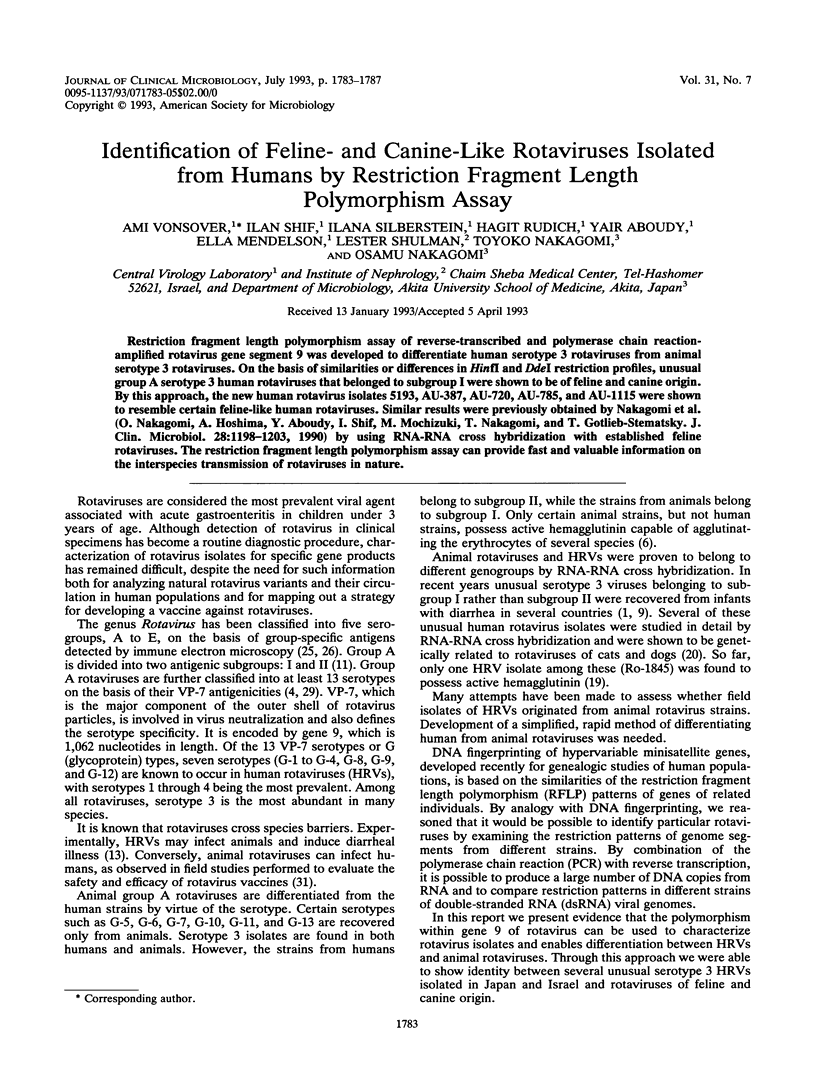
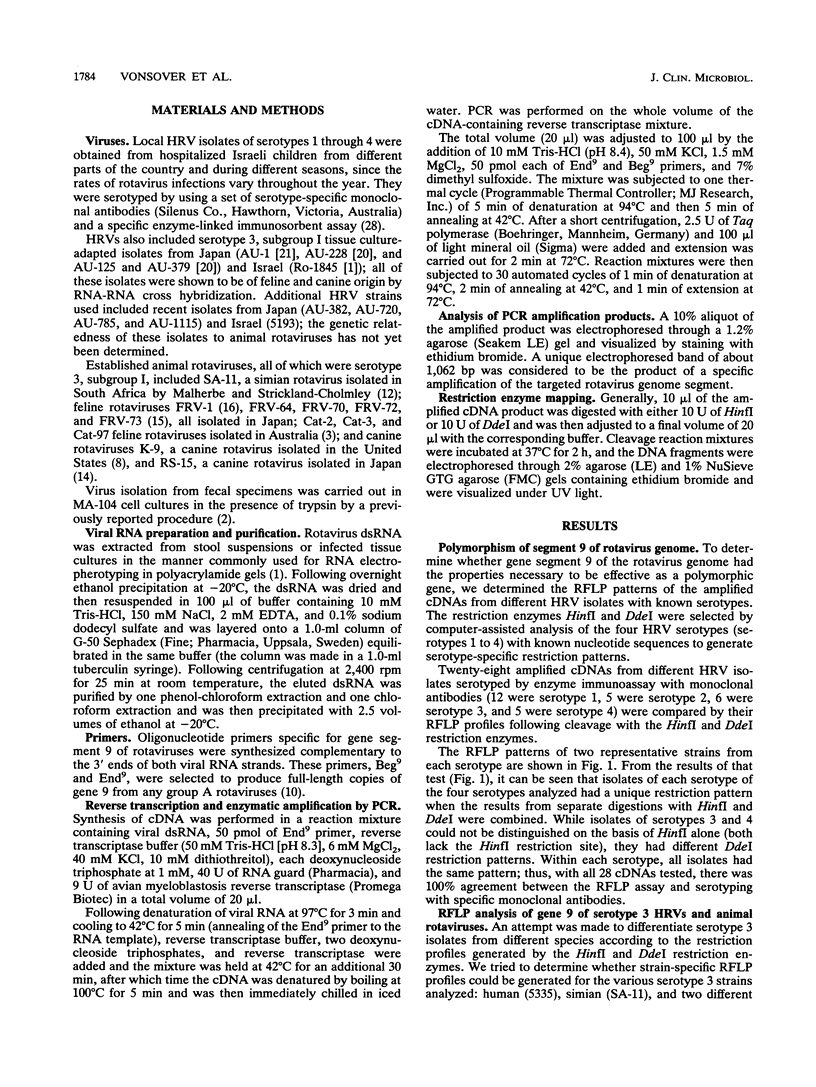
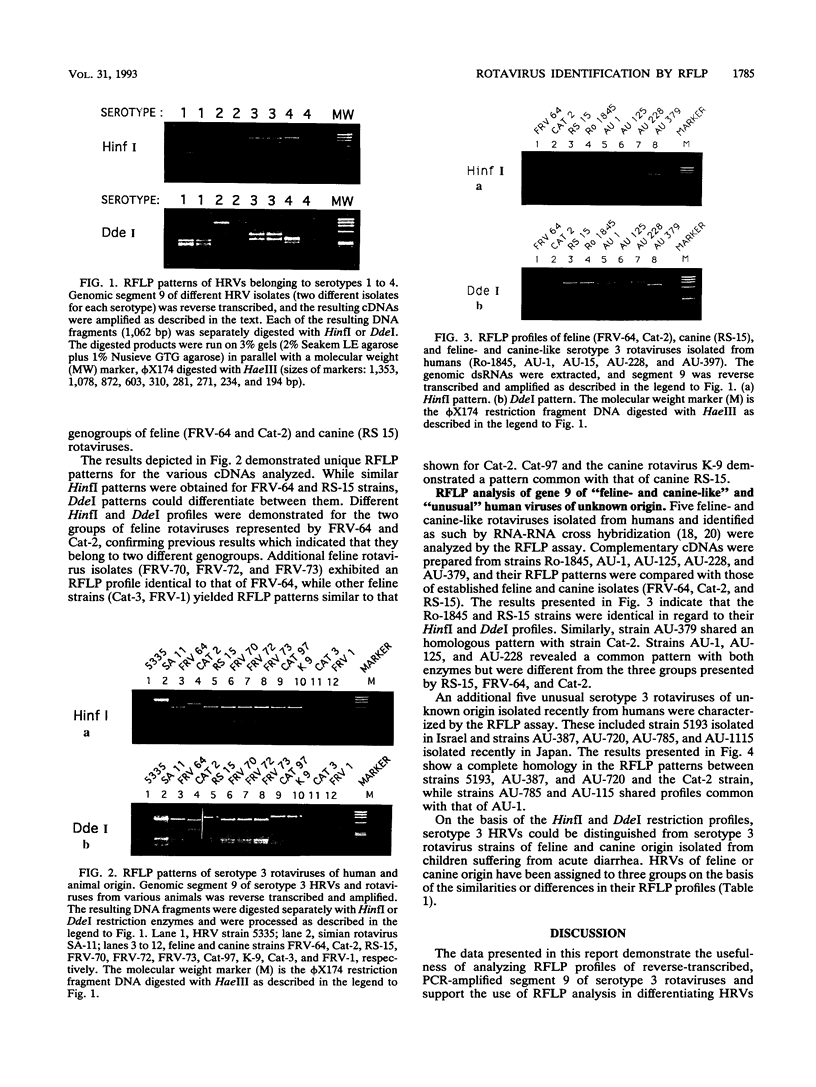
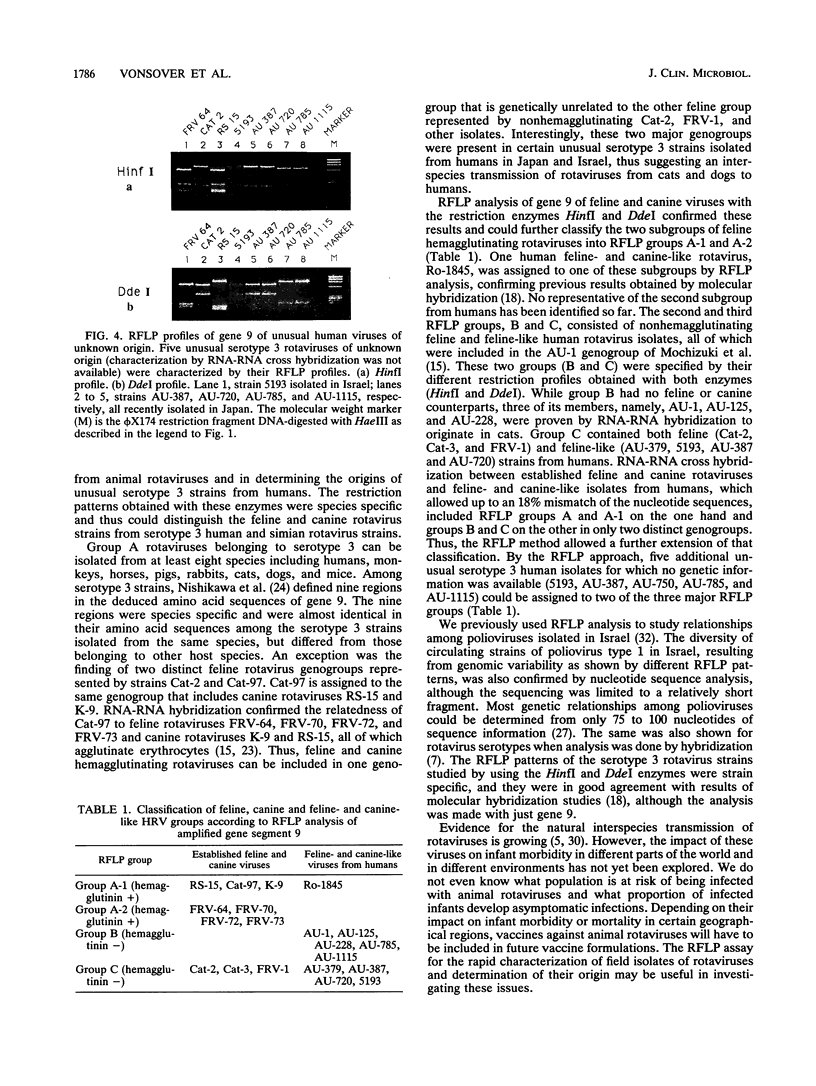
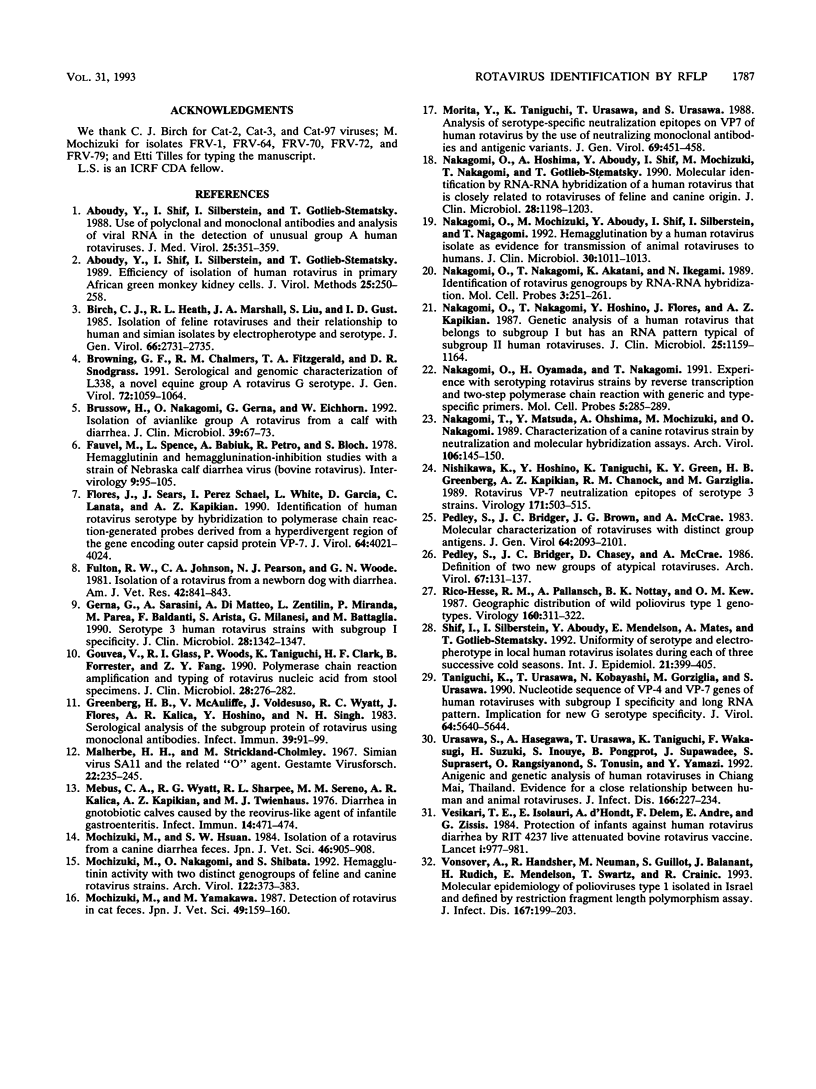
Images in this article
Selected References
These references are in PubMed. This may not be the complete list of references from this article.
- Aboudy Y., Shif I., Zilberstein I., Gotlieb-Stematsky T. Use of polyclonal and monoclonal antibodies and analysis of viral RNA in the detection of unusual group A human rotaviruses. J Med Virol. 1988 Jul;25(3):351–359. doi: 10.1002/jmv.1890250312. [DOI] [PubMed] [Google Scholar]
- Birch C. J., Heath R. L., Marshall J. A., Liu S., Gust I. D. Isolation of feline rotaviruses and their relationship to human and simian isolates by electropherotype and serotype. J Gen Virol. 1985 Dec;66(Pt 12):2731–2735. doi: 10.1099/0022-1317-66-12-2731. [DOI] [PubMed] [Google Scholar]
- Browning G. F., Chalmers R. M., Fitzgerald T. A., Snodgrass D. R. Serological and genomic characterization of L338, a novel equine group A rotavirus G serotype. J Gen Virol. 1991 May;72(Pt 5):1059–1064. doi: 10.1099/0022-1317-72-5-1059. [DOI] [PubMed] [Google Scholar]
- Brüssow H., Nakagomi O., Gerna G., Eichhorn W. Isolation of an avianlike group A rotavirus from a calf with diarrhea. J Clin Microbiol. 1992 Jan;30(1):67–73. doi: 10.1128/jcm.30.1.67-73.1992. [DOI] [PMC free article] [PubMed] [Google Scholar]
- Fauvel M., Spence L., Babiuk L. A., Petro R., Bloch S. Hemagglutination and hemagglutination-inhibition studies with a strain of Nebraska calf diarrhea virus (bovine rotavirus). Intervirology. 1978;9(2):95–105. doi: 10.1159/000148927. [DOI] [PubMed] [Google Scholar]
- Flores J., Sears J., Schael I. P., White L., Garcia D., Lanata C., Kapikian A. Z. Identification of human rotavirus serotype by hybridization to polymerase chain reaction-generated probes derived from a hyperdivergent region of the gene encoding outer capsid protein VP7. J Virol. 1990 Aug;64(8):4021–4024. doi: 10.1128/jvi.64.8.4021-4024.1990. [DOI] [PMC free article] [PubMed] [Google Scholar]
- Fulton R. W., Johnson C. A., Pearson N. J., Woode G. N. Isolation of a rotavirus from a newborn dog with diarrhea. Am J Vet Res. 1981 May;42(5):841–843. [PubMed] [Google Scholar]
- Gerna G., Sarasini A., Di Matteo A., Zentilin L., Miranda P., Parea M., Baldanti F., Arista S., Milanesi G., Battaglia M. Serotype 3 human rotavirus strains with subgroup I specificity. J Clin Microbiol. 1990 Jun;28(6):1342–1347. doi: 10.1128/jcm.28.6.1342-1347.1990. [DOI] [PMC free article] [PubMed] [Google Scholar]
- Gouvea V., Glass R. I., Woods P., Taniguchi K., Clark H. F., Forrester B., Fang Z. Y. Polymerase chain reaction amplification and typing of rotavirus nucleic acid from stool specimens. J Clin Microbiol. 1990 Feb;28(2):276–282. doi: 10.1128/jcm.28.2.276-282.1990. [DOI] [PMC free article] [PubMed] [Google Scholar]
- Greenberg H., McAuliffe V., Valdesuso J., Wyatt R., Flores J., Kalica A., Hoshino Y., Singh N. Serological analysis of the subgroup protein of rotavirus, using monoclonal antibodies. Infect Immun. 1983 Jan;39(1):91–99. doi: 10.1128/iai.39.1.91-99.1983. [DOI] [PMC free article] [PubMed] [Google Scholar]
- Malherbe H. H., Strickland-Cholmley M. Simian virus SA11 and the related O agent. Arch Gesamte Virusforsch. 1967;22(1):235–245. doi: 10.1007/BF01240518. [DOI] [PubMed] [Google Scholar]
- Mebus C. A., Wyatt R. G., Sharpee R. L., Sereno M. M., Kalica A. R., Kapikian A. Z., Twiehaus M. J. Diarrhea in gnotobiotic calves caused by the reovirus-like agent of human infantile gastroenteritis. Infect Immun. 1976 Aug;14(2):471–474. doi: 10.1128/iai.14.2.471-474.1976. [DOI] [PMC free article] [PubMed] [Google Scholar]
- Mochizuki M., Hsüan S. Isolation of a rotavirus from canine diarrheal feces. Nihon Juigaku Zasshi. 1984 Dec;46(6):905–908. doi: 10.1292/jvms1939.46.905. [DOI] [PubMed] [Google Scholar]
- Mochizuki M., Nakagomi O., Shibata S. Hemagglutinin activity of two distinct genogroups of feline and canine rotavirus strains. Arch Virol. 1992;122(3-4):373–381. doi: 10.1007/BF01317199. [DOI] [PubMed] [Google Scholar]
- Mochizuki M., Yamakawa M. Detection of rotaviruses in cat feces. Nihon Juigaku Zasshi. 1987 Feb;49(1):159–160. doi: 10.1292/jvms1939.49.159. [DOI] [PubMed] [Google Scholar]
- Morita Y., Taniguchi K., Urasawa T., Urasawa S. Analysis of serotype-specific neutralization epitopes on VP7 of human rotavirus by the use of neutralizing monoclonal antibodies and antigenic variants. J Gen Virol. 1988 Feb;69(Pt 2):451–458. doi: 10.1099/0022-1317-69-2-451. [DOI] [PubMed] [Google Scholar]
- Nakagomi O., Mochizuki M., Aboudy Y., Shif I., Silberstein I., Nakagomi T. Hemagglutination by a human rotavirus isolate as evidence for transmission of animal rotaviruses to humans. J Clin Microbiol. 1992 Apr;30(4):1011–1013. doi: 10.1128/jcm.30.4.1011-1013.1992. [DOI] [PMC free article] [PubMed] [Google Scholar]
- Nakagomi O., Nakagomi T., Akatani K., Ikegami N. Identification of rotavirus genogroups by RNA-RNA hybridization. Mol Cell Probes. 1989 Sep;3(3):251–261. doi: 10.1016/0890-8508(89)90006-6. [DOI] [PubMed] [Google Scholar]
- Nakagomi O., Nakagomi T., Hoshino Y., Flores J., Kapikian A. Z. Genetic analysis of a human rotavirus that belongs to subgroup I but has an RNA pattern typical of subgroup II human rotaviruses. J Clin Microbiol. 1987 Jul;25(7):1159–1164. doi: 10.1128/jcm.25.7.1159-1164.1987. [DOI] [PMC free article] [PubMed] [Google Scholar]
- Nakagomi O., Ohshima A., Aboudy Y., Shif I., Mochizuki M., Nakagomi T., Gotlieb-Stematsky T. Molecular identification by RNA-RNA hybridization of a human rotavirus that is closely related to rotaviruses of feline and canine origin. J Clin Microbiol. 1990 Jun;28(6):1198–1203. doi: 10.1128/jcm.28.6.1198-1203.1990. [DOI] [PMC free article] [PubMed] [Google Scholar]
- Nakagomi O., Oyamada H., Nakagomi T. Experience with serotyping rotavirus strains by reverse transcription and two-step polymerase chain reaction with generic and type-specific primers. Mol Cell Probes. 1991 Aug;5(4):285–289. doi: 10.1016/0890-8508(91)90051-k. [DOI] [PubMed] [Google Scholar]
- Nakagomi T., Matsuda Y., Ohshima A., Mochizuki M., Nakagomi O. Characterization of a canine rotavirus strain by neutralization and molecular hybridization assays. Arch Virol. 1989;106(1-2):145–150. doi: 10.1007/BF01311046. [DOI] [PubMed] [Google Scholar]
- Nishikawa K., Hoshino Y., Taniguchi K., Green K. Y., Greenberg H. B., Kapikian A. Z., Chanock R. M., Gorziglia M. Rotavirus VP7 neutralization epitopes of serotype 3 strains. Virology. 1989 Aug;171(2):503–515. doi: 10.1016/0042-6822(89)90620-x. [DOI] [PubMed] [Google Scholar]
- Pedley S., Bridger J. C., Brown J. F., McCrae M. A. Molecular characterization of rotaviruses with distinct group antigens. J Gen Virol. 1983 Oct;64(Pt 10):2093–2101. doi: 10.1099/0022-1317-64-10-2093. [DOI] [PubMed] [Google Scholar]
- Pedley S., Bridger J. C., Chasey D., McCrae M. A. Definition of two new groups of atypical rotaviruses. J Gen Virol. 1986 Jan;67(Pt 1):131–137. doi: 10.1099/0022-1317-67-1-131. [DOI] [PubMed] [Google Scholar]
- Rico-Hesse R., Pallansch M. A., Nottay B. K., Kew O. M. Geographic distribution of wild poliovirus type 1 genotypes. Virology. 1987 Oct;160(2):311–322. doi: 10.1016/0042-6822(87)90001-8. [DOI] [PubMed] [Google Scholar]
- Shif I., Silberstein I., Aboudy Y., Mendelson E., Mates A., Gotlieb-Stematsky T. Uniformity of serotype and electropherotype in local human rotavirus isolates during each of three successive cold seasons. Int J Epidemiol. 1992 Apr;21(2):399–405. doi: 10.1093/ije/21.2.399. [DOI] [PubMed] [Google Scholar]
- Taniguchi K., Urasawa T., Kobayashi N., Gorziglia M., Urasawa S. Nucleotide sequence of VP4 and VP7 genes of human rotaviruses with subgroup I specificity and long RNA pattern: implication for new G serotype specificity. J Virol. 1990 Nov;64(11):5640–5644. doi: 10.1128/jvi.64.11.5640-5644.1990. [DOI] [PMC free article] [PubMed] [Google Scholar]
- Urasawa S., Hasegawa A., Urasawa T., Taniguchi K., Wakasugi F., Suzuki H., Inouye S., Pongprot B., Supawadee J., Suprasert S. Antigenic and genetic analyses of human rotaviruses in Chiang Mai, Thailand: evidence for a close relationship between human and animal rotaviruses. J Infect Dis. 1992 Aug;166(2):227–234. doi: 10.1093/infdis/166.2.227. [DOI] [PubMed] [Google Scholar]
- Vesikari T., Isolauri E., D'Hondt E., Delem A., André F. E., Zissis G. Protection of infants against rotavirus diarrhoea by RIT 4237 attenuated bovine rotavirus strain vaccine. Lancet. 1984 May 5;1(8384):977–981. doi: 10.1016/s0140-6736(84)92323-7. [DOI] [PubMed] [Google Scholar]
- Vonsover A., Handsher R., Neuman M., Guillot S., Balanant J., Rudich H., Mendelson E., Swartz T., Crainic R. Molecular epidemiology of type 1 polioviruses isolated in Israel and defined by restriction fragment length polymorphism assay. J Infect Dis. 1993 Jan;167(1):199–203. doi: 10.1093/infdis/167.1.199. [DOI] [PubMed] [Google Scholar]






